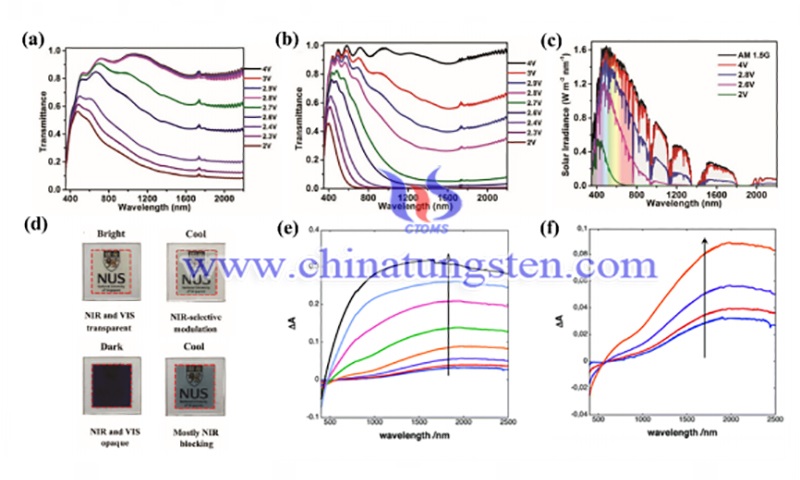Application of Tungsten Oxide in Near-Infrared Electrochromic Devices
- Details
- Category: Tungsten's News
- Published on Sunday, 12 February 2023 18:55
Researchers fabricated 1D W18O49 nanomaterials for near-infrared shielding of electrochromic devices. These tungsten oxide films all had high transmittance in the visible region. However, the researchers did not explore the change in transmittance during the color change. The researchers fabricated a flexible electrochromic device (ECD) with 63% transmission modulation between 760 and 1600 nm, yet did not tap the relationship between the transmission of visible and near-infrared light.
When the halogen lamp worked as a radiation source, it was found that the temperature at the back of the test chamber was reduced by 3.3°C when the EC window was darkened compared to the value when the Electrochromic (EC) window was bleached, proving that the EC film can effectively block the heat.

Inverse opal (IO) structure of tungsten oxides, IO structure is a three-dimensional layered porous structure. It is favored for its large specific surface area and artificially ordered periodic layered structure. This structure is usually achieved by a template-assisted method, where the template used is an opal structure. After the material is deposited on the template, the template is removed and the IO structure is obtained. Its large specific surface area is the result of the porosity obtained after the removal of the template material, which allows better electrolyte permeation and accelerated electron and ion transport.
Due to the periodicity and homogeneity of the template, the final product also has a periodic and homogeneous structure, thus enhancing the reflection and refraction of light and facilitating the effective reduction of visible and near-infrared light transmission in electrochromic devices. Yang et al. used PS of different diameters as templates to fabricate ordered microporous tungsten oxide IO films, followed by a process of removing PS by immersing the samples in tetrahydrofuran (THF), after which they obtained porous tungsten-oxide films. This porous film showed high optical density and coloring efficiency in the NIR region compared to the dense tungsten-oxide film.
They also found that smaller porous diameters and higher integration of ordered porous structures translate into better EC performance. Later, Nguyen et al. reported a homogeneous SnO2-WO3 core-shell IO structure designed to control the transmission of NIR radiation well without degrading the visible light transmission. They first obtained the SnO2 IO structure after removing the PS on the basis of ITO coating. Subsequently, they performed an electrodeposition of WO3.

Finally, a specific core-shell SnO2-WO3 IO structure was successfully obtained. This EC film displayed high visible transparency of 70.3%, and 67.1% at the wavelength of 400 nm at a colored state, and blocked 62% of the NIR radiation at the same time. Later, using a similar approach, Ling et al. also made a TiO2-WO3 core-shell IO structure, which also showed good electrochromic properties in the near-infrared.
Reference: Han W, Shi Q, Hu R. Advances in electrochemical energy devices constructed with tungsten oxide-based nanomaterials[J]. Nanomaterials, 2021, 11(3): 692.
- Tungsten Manufacturer & Supplier, Chinatungsten Online: www.chinatungsten.com
- Tungsten News & Prices of China Tungsten Industry Association: www.ctia.com.cn
- Molybdenum News & Price: news.molybdenum.com.cn
- Tel.: 86 592 5129696; Fax: 86 592 5129797; Email: sales@chinatungsten.com



 sales@chinatungsten.com
sales@chinatungsten.com